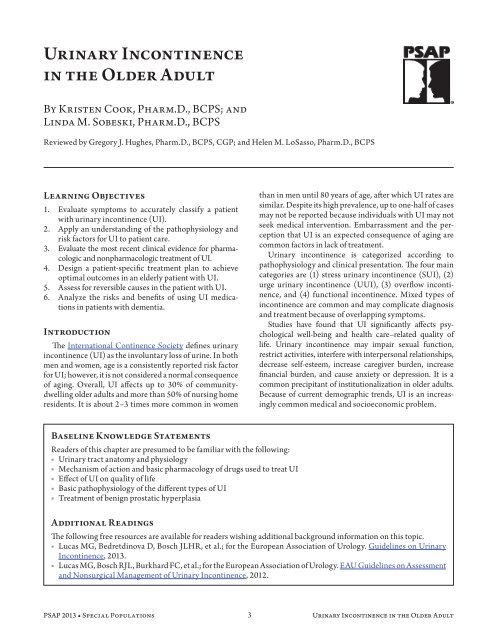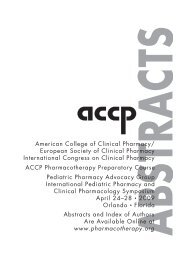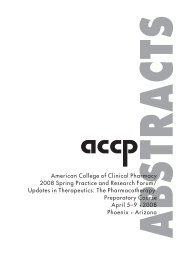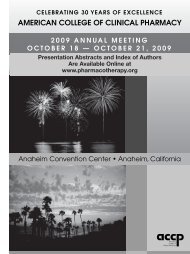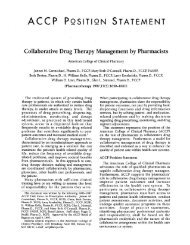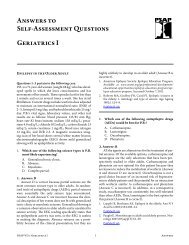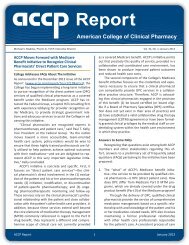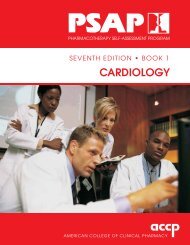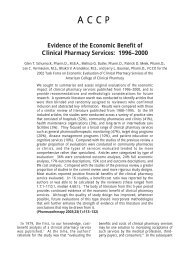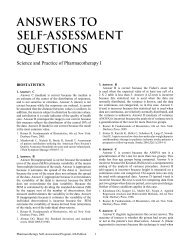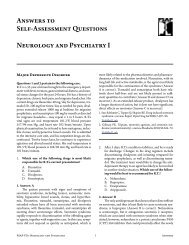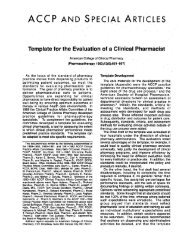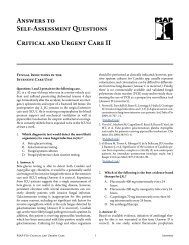Sample PDF - ACCP
Sample PDF - ACCP
Sample PDF - ACCP
Create successful ePaper yourself
Turn your PDF publications into a flip-book with our unique Google optimized e-Paper software.
Urinary Incontinence<br />
in the Older Adult<br />
By Kristen Cook, Pharm.D., BCPS; and<br />
Linda M. Sobeski, Pharm.D., BCPS<br />
Reviewed by Gregory J. Hughes, Pharm.D., BCPS, CGP; and Helen M. LoSasso, Pharm.D., BCPS<br />
Learning Objectives<br />
1. Evaluate symptoms to accurately classify a patient<br />
with urinary incontinence (UI).<br />
2. Apply an understanding of the pathophysiology and<br />
risk factors for UI to patient care.<br />
3. Evaluate the most recent clinical evidence for pharmacologic<br />
and nonpharmacologic treatment of UI.<br />
4. Design a patient-specific treatment plan to achieve<br />
optimal outcomes in an elderly patient with UI.<br />
5. Assess for reversible causes in the patient with UI.<br />
6. Analyze the risks and benefits of using UI medications<br />
in patients with dementia.<br />
Introduction<br />
The International Continence Society defines urinary<br />
incontinence (UI) as the involuntary loss of urine. In both<br />
men and women, age is a consistently reported risk factor<br />
for UI; however, it is not considered a normal consequence<br />
of aging. Overall, UI affects up to 30% of communitydwelling<br />
older adults and more than 50% of nursing home<br />
residents. It is about 2–3 times more common in women<br />
than in men until 80 years of age, after which UI rates are<br />
similar. Despite its high prevalence, up to one-half of cases<br />
may not be reported because individuals with UI may not<br />
seek medical intervention. Embarrassment and the perception<br />
that UI is an expected consequence of aging are<br />
common factors in lack of treatment.<br />
Urinary incontinence is categorized according to<br />
pathophysiology and clinical presentation. The four main<br />
categories are (1) stress urinary incontinence (SUI), (2)<br />
urge urinary incontinence (UUI), (3) overflow incontinence,<br />
and (4) functional incontinence. Mixed types of<br />
incontinence are common and may complicate diagnosis<br />
and treatment because of overlapping symptoms.<br />
Studies have found that UI significantly affects psychological<br />
well-being and health care–related quality of<br />
life. Urinary incontinence may impair sexual function,<br />
restrict activities, interfere with interpersonal relationships,<br />
decrease self-esteem, increase caregiver burden, increase<br />
financial burden, and cause anxiety or depression. It is a<br />
common precipitant of institutionalization in older adults.<br />
Because of current demographic trends, UI is an increasingly<br />
common medical and socioeconomic problem.<br />
Baseline Knowledge Statements<br />
Readers of this chapter are presumed to be familiar with the following:<br />
■■<br />
Urinary tract anatomy and physiology<br />
■■<br />
Mechanism of action and basic pharmacology of drugs used to treat UI<br />
■■<br />
Effect of UI on quality of life<br />
■■<br />
Basic pathophysiology of the different types of UI<br />
■■<br />
Treatment of benign prostatic hyperplasia<br />
Additional Readings<br />
The following free resources are available for readers wishing additional background information on this topic.<br />
■■<br />
Lucas MG, Bedretdinova D, Bosch JLHR, et al.; for the European Association of Urology. Guidelines on Urinary<br />
Incontinence, 2013.<br />
■■<br />
Lucas MG, Bosch RJL, Burkhard FC, et al.; for the European Association of Urology. EAU Guidelines on Assessment<br />
and Nonsurgical Management of Urinary Incontinence, 2012.<br />
PSAP 2013 • Special Populations 3 Urinary Incontinence in the Older Adult
Abbreviations in This Chapter<br />
BPH<br />
CVA<br />
LUTS<br />
OAB<br />
PMR<br />
PVR<br />
RCT<br />
SNS<br />
SUI<br />
UI<br />
UTI<br />
UUI<br />
Benign prostatic hyperplasia<br />
Cerebrovascular accident<br />
Lower urinary tract symptoms<br />
Overactive bladder<br />
Pelvic muscle rehabilitation<br />
Post void residual<br />
Randomized controlled trial<br />
Sacral nerve stimulation<br />
Stress urinary incontinence<br />
Urinary incontinence<br />
Urinary tract infection<br />
Urge urinary incontinence<br />
Pathophysiology<br />
Continence requires both an appropriately functioning<br />
lower urinary tract and the physical and cognitive ability<br />
to use a toilet. Function of the lower urinary tract is complicated<br />
and not completely understood. In individuals<br />
with normal physiology, activation of the sympathetic nervous<br />
system aids in closing the bladder neck; the bladder<br />
fills without leakage while the parasympathetic nervous<br />
system is inhibited. As the bladder fills and pressure rises,<br />
increased parasympathetic tone causes the detrusor muscle<br />
to contract and the bladder to empty. The primary<br />
neurotransmitter involved in bladder contraction is acetylcholine,<br />
which acts at muscarinic receptors. Muscarinic<br />
2 receptors are usually found in the lower urinary tract;<br />
however, most UI drug therapy targets the muscarinic 3<br />
receptors, which are thought to have a larger role in bladder<br />
emptying. α-Adrenergic receptors are involved in<br />
urethral smooth muscle control.<br />
Several classifications of incontinence are based on the<br />
underlying problem in the lower urinary tract. Although<br />
the terms overactive bladder (OAB) and urge incontinence<br />
are used interchangeably, they describe two different conditions.<br />
Overactive bladder is a symptom syndrome that<br />
includes frequency, urgency, and nocturia. These can all<br />
occur with or without urge incontinence. Although the<br />
definitions are distinct, these two conditions are treated<br />
in the same manner. Table 1-1 outlines the main classifications<br />
of UI.<br />
Age-related changes within the urinary tract contribute<br />
to the increased prevalence of UI in the older population.<br />
These changes include decreases in bladder compliance,<br />
Table 1-1. Types of Urinary Incontinence<br />
Type Definition Common Causes<br />
Stress<br />
Urge<br />
Overflow<br />
Functional<br />
Involuntary loss of urine (small amounts) with<br />
increasing intraabdominal pressure (e.g., coughing,<br />
laughing, exercise)<br />
Leakage of urine (can be large volumes) because of<br />
inability to delay voiding after sensation of bladder<br />
fullness is perceived<br />
Leakage of urine (small amounts) caused by either<br />
mechanical forces on an overdistended bladder<br />
(resulting in stress leakage) or other effects of<br />
urinary retention on bladder and sphincter function<br />
(contributing to urge leakage)<br />
Urinary accidents associated with the inability to<br />
toilet because of impairment of cognitive and or<br />
physical functioning, psychological unwillingness,<br />
or environmental barriers<br />
Weak pelvic floor muscles (childbirth, pregnancy,<br />
menopause)<br />
Bladder outlet or urethral sphincter weakness<br />
Post-urologic surgery<br />
Detrusor overactivity, either isolated or associated with<br />
one or more of the following:<br />
Local genitourinary conditions (e.g., tumors, stones,<br />
diverticula, outflow obstruction)<br />
CNS disorder (e.g., stroke, parkinsonism, dementia,<br />
spinal cord injury)<br />
Anatomic obstruction by prostate, stricture, cystocele<br />
Acontractile bladder associated with diabetes or spinal<br />
cord injury<br />
Neurogenic associated with multiple sclerosis or other<br />
spinal cord lesions<br />
Medication effect (see Table 1-2)<br />
Severe dementia or other neurologic disorder<br />
Psychological factors such as depression and hostility<br />
CNS = central nervous system.<br />
Adapted with permission from Halter JB, Ouslander JG, Tinetti ME, et al. Hazzard’s Geriatric Medicine and Gerontology, 6th ed. New York:<br />
McGraw-Hill, 2009:720.<br />
PSAP 2013 • Special Populations 4 Urinary Incontinence in the Older Adult
ladder capacity, urethral closing pressure, and ability<br />
to postpone voiding; increases in involuntary detrusor<br />
contractions, post void residual (PVR), and frequency<br />
of voiding; and weakened pelvic floor musculature (in<br />
women) and prostatic enlargement (in men). In addition<br />
to age-associated factors, chronic disease burden can contribute<br />
to UI.<br />
Epidemiology/Functional Impact<br />
Prevalence estimates of UI vary significantly by type of<br />
incontinence, definition of UI, and target populations, as<br />
well as with variations in study design. Urinary incontinence<br />
is reported to affect 30%–60% of women who are<br />
middle-aged and older. The NOBLE (National Overactive<br />
Bladder Evaluation) Program estimated that one-third of<br />
women older than 65 suffer from OAB, with about twothirds<br />
of these cases associated with incontinence. Stress<br />
urinary incontinence affects about 13% of women 19–44<br />
years of age and 22% of women 45–64 years of age. In<br />
older women, mixed incontinence is most common and<br />
accounts for about 50% of all cases.<br />
Risk factors for UI in women include age, race/ethnicity,<br />
childbirth, hysterectomy, oral hormone therapy,<br />
obesity, cognitive impairment, mobility impairment, and<br />
diabetes. Control of the lower urinary tract system in<br />
women is directly affected by loss of pelvic organ support<br />
and loss of estrogen at menopause. Up to 70% of women<br />
with UI relate the onset of symptoms with menopause.<br />
Both qualitative and quantitative changes in the connective<br />
tissue of the urogenital tract are believed to contribute<br />
to SUI. Recent investigations suggest a higher prevalence<br />
of SUI in postmenopausal women who possess a collagen<br />
type I α1 Sp1 polymorphism (Sioutis 2011). Type 1 collagen<br />
is the main structural protein in connective tissue.<br />
Polymorphism may be associated with alterations in the<br />
quality and quantity of pelvic floor collagen.<br />
Because UI is more common in women, there are<br />
fewer studies evaluating the prevalence and epidemiology<br />
of UI in men. In men, UI has a later and more sudden<br />
onset than in women. The National Health and Nutrition<br />
Examination Study reported an overall UI prevalence in<br />
men of 4.5%; this prevalence increased to 16% in men 75<br />
years or older. Factors associated with UI in men of this<br />
study were age, major depression, benign prostatic hyperplasia<br />
(BPH), and hypertension (Markland 2010). In<br />
other studies, associated risk factors included lower urinary<br />
tract symptoms (LUTS), impaired mobility, and<br />
urethral surgery or irradiation. Despite surgical advances,<br />
UI remains a common complication for 12%–16% of men<br />
after surgery for prostate cancer.<br />
Several comorbid conditions are associated with UI in<br />
both men and women. Urinary incontinence is common<br />
after a cerebrovascular accident (CVA), with 40%–60%<br />
of patients experiencing UI during hospitalization<br />
immediately after a CVA. The incidence significantly<br />
declines over several months; however, up to one-third of<br />
patients continue to have UI at 12 months after a CVA.<br />
A case-control analysis noted a higher incidence of UI in<br />
community-dwelling individuals with CVA (28%) than in<br />
those without stroke (20%) (Divani 2011). Risk factors for<br />
UI after stroke include hemiparesis, depression, impaired<br />
cognition, age older than 75 years, dysphagia, visual field<br />
defect, and motor weakness.<br />
Other conditions resulting in impaired mobility and/<br />
or cognition (e.g., Parkinson disease, osteoarthritis,<br />
dementia) are also associated with UI. Urinary frequency<br />
and nocturia associated with congestive heart failure or<br />
peripheral venous insufficiency can contribute to UI.<br />
Diabetes is an independent risk factor for developing UI<br />
because of polyneuropathy, changes in fluid intake, and<br />
diabetes-related functional impairment.<br />
Urinary incontinence has a significant socioeconomic<br />
impact. Individuals with UI may suffer medical<br />
and quality-of-life consequences that compromise overall<br />
well-being. Urinary incontinence has been associated<br />
with an increased risk of urinary tract infections (UTIs),<br />
pressure ulcers, falls, fractures, and sleep disturbance,<br />
all of which may lead to functional impairment and<br />
decline in overall health status. Urinary incontinence<br />
is a well-recognized risk factor for nursing home placement.<br />
Incontinence after a stroke adversely affects 2-year<br />
survival, disability, and functional outcome; it is also associated<br />
with a 4-fold increased risk of institutionalization<br />
at 1 year (Kolominsky-Rabas 2003). Psychological and<br />
social complications of UI include isolation, depression,<br />
anxiety, impaired sexual function, decreased work productivity,<br />
increased functional dependency, and increased<br />
caregiver burden.<br />
According to the National Institutes of Health, the<br />
annual direct cost of UI in the United States was about<br />
$19.5 billion in 2000. Up to 70% of the cost is attributed<br />
to routine care such as incontinence pads and diapers,<br />
protective items, laundry, odor control, and skin care<br />
products. A major contributor to this figure is the cost of<br />
institutional care.<br />
Clinical Evaluation and Diagnosis<br />
In a large Medicare study, only 56% of patients who<br />
self-reported UI symptoms had them discussed at their<br />
most recent health care visit (Mardon 2006). Screening<br />
is necessary to identify patients because many patients do<br />
not report symptoms. Screening questions such as “Do<br />
you ever leak urine when you do not want to?” and “Do<br />
you ever leak urine when you cough, sneeze, or laugh?”<br />
are now part of health care quality assessments through<br />
Medicare.<br />
Women in the Medicare population reported incontinence<br />
symptoms at a rate of 43.6% and men at a rate of<br />
27.9% (Mardon 2006). The reporting of bothersome<br />
symptoms increased with age for both men and women.<br />
PSAP 2013 • Special Populations 5 Urinary Incontinence in the Older Adult
The Agency for Healthcare Research and Quality<br />
recommends a basic diagnostic evaluation for UI. A thorough<br />
history should focus on specific symptoms, as well<br />
as quality of life and impact on the patient and caregivers.<br />
A bladder diary can be used to identify patterns and<br />
measure treatment efficacy. Bladder diaries keep track of<br />
things such as liquid intake, number of trips to the bathroom,<br />
activities during leakage, strength of urge to void,<br />
and accidental leaks. A freely accessible bladder diary can<br />
be found online courtesy of the National Institutes of<br />
Health. An abdominal, rectal, and genital physical examination<br />
should be performed, and a urinalysis should be<br />
used to rule out infection or glucosuria. There is no need<br />
to treat asymptomatic bacteriuria in the institutionalized<br />
patient; treatment has not been shown to decrease<br />
UI (Lucas 2012; Johnson 2009). In noninstitutionalized<br />
patients, this is less clear. Treatment may be attempted<br />
first to see whether incontinence improves (Johnson<br />
2009). Some groups recommend that PVRs be measured<br />
for all patients; however, this is controversial. The<br />
American Urological Association recommends a PVR<br />
if, after a history and urinalysis, the diagnosis of OAB<br />
is unclear. The European Association of Urology cites a<br />
lack of evidence for routine PVR measurement. Post void<br />
residuals help determine the amount of urinary retention<br />
and should be performed in patients at high risk of urinary<br />
retention, including those who have diabetes, are taking<br />
anticholinergic drugs, have a neurologic disorder, or have<br />
symptoms of voiding difficulty or retention. A PVR of less<br />
than 100 mL is normal; greater than 200 mL is considered<br />
abnormal. Between those two values, the PVR must<br />
be interpreted with other information about the patient.<br />
Specialty testing (e.g., urodynamics) is not necessary during<br />
initial evaluation and treatment.<br />
Another important part of the initial evaluation of<br />
UI is to identify any reversible causes or contributors.<br />
Several chronic diseases and conditions can contribute to<br />
UI. These include UTIs, atrophic vaginitis, urinary tract<br />
surgeries (prostatectomy), constipation, uncontrolled<br />
diabetes, chronic venous insufficiency, delirium, and<br />
mobility restraint. Appropriate treatment for each of these<br />
conditions should be implemented and incontinence reassessed.<br />
Several drugs can also cause or exacerbate UI<br />
(Table 1-2).<br />
Management of UI<br />
Nonpharmacologic Treatment<br />
Nonpharmacologic and behavioral strategies are<br />
important in the comprehensive management of UI.<br />
Noninvasive lifestyle and behavioral interventions are<br />
the first-line treatment of choice in the elderly population.<br />
Table 1-2. Drugs That Can Affect Continence<br />
Drug<br />
Alcohol<br />
α-Adrenergic agonists<br />
α-Adrenergic blockers<br />
ACE inhibitors<br />
Anticholinergics<br />
Antipsychotics<br />
Calcium channel blockers<br />
Cholinesterase inhibitors<br />
Estrogen<br />
GABAnergic agents<br />
(gabapentin and pregabalin)<br />
Loop diuretics<br />
Narcotic analgesics<br />
NSAIDs<br />
Sedative hypnotics<br />
Thiazolidinediones<br />
Effects on Continence<br />
Increased frequency, urgency, sedation, immobility<br />
Outlet obstruction (men)<br />
Stress leakage (women)<br />
Cough worsens stress incontinence<br />
Impaired emptying, retention, delirium, sedation, constipation, fecal impaction<br />
Anticholinergic effects plus rigidity and immobility<br />
Impaired detrusor contractility and retention; dihydropyridine agents can cause pedal<br />
edema, leading to nocturnal polyuria<br />
Urinary incontinence, interactions with antimuscarinics<br />
Worsens stress and mixed leakage in women<br />
Edema causing nocturia and nighttime incontinence<br />
Polyuria, frequency, urgency<br />
Urinary retention, fecal impaction, sedation, delirium<br />
Pedal edema causing nocturnal polyuria<br />
Sedation, delirium, immobility<br />
Pedal edema causing nocturnal polyuria<br />
ACE = angiotensin-converting enzyme; GABA = γ-aminobutyric acid; NSAID = nonsteroidal anti-inflammatory drug; TCA = tricyclic antidepressant.<br />
Adapted with permission from: Reuben DB, Herr KA, Pacala JT, et al. Geriatrics at Your Fingertips, 14th ed. New York: American Geriatrics Society, 2012.<br />
PSAP 2013 • Special Populations 6 Urinary Incontinence in the Older Adult
Advantages of behavioral interventions include low cost,<br />
absence of adverse effects, and ease of implementation.<br />
These interventions should be individually tailored; their<br />
effectiveness largely depends on patient motivation, functional<br />
capacity, and cognitive function.<br />
Lifestyle Modification<br />
Lifestyle modifications for UI include smoking cessation,<br />
caffeine and alcohol reduction, weight loss, and<br />
modified fluid intake. The relationship between caffeine<br />
intake and OAB appears to be dose-dependent.<br />
Patients consuming greater than 400 mg/day of caffeine<br />
are 2.4 times more likely to experience detrusor instability.<br />
Reductions in caffeine intake should be undertaken<br />
gradually to avoid withdrawal symptoms. Data exist to<br />
suggest obesity and type 2 diabetes mellitus as independent<br />
risk factors for UI in women. In the Action for Health<br />
in Diabetes (Look AHEAD) trial, moderate weight loss<br />
was reported to reduce the incidence but not improve<br />
the resolution rate of UI among overweight women with<br />
type 2 diabetes mellitus (Phelan 2012). Another recent<br />
study of UI in overweight women reported that weight<br />
loss decreased the cost of incontinence management by<br />
81% and was independently associated with decreased<br />
frequency of incontinence (Subak 2012). Modified fluid<br />
intake encourages reductions in fluid intake during the<br />
evening hours. Many patients will restrict fluid on their<br />
own in an attempt to manage incontinence. Patient education<br />
regarding the timing of fluid intake is critical; overall,<br />
fluid restriction is not recommended because it may lead<br />
to dehydration and increased risk of UTIs.<br />
Additional supportive measures include education<br />
about bladder health, use of absorbent products, and<br />
appropriate skin care. Environmental interventions such<br />
as toilet proximity, safe path to bathroom, raised toilet<br />
seats, grab bars, and toilet substitutes (e.g., urinals, commodes)<br />
are particularly useful for patients with functional<br />
incontinence.<br />
Behavioral Therapy<br />
The goal of behavioral interventions is to achieve a satisfactory<br />
voiding pattern. Patient-dependent behavioral<br />
therapies require functional capacity, learning ability,<br />
and patient motivation. Patients with functional disability<br />
or cognitive impairment require systematic toileting<br />
assistance, and they are often dependent on caregivers for<br />
successful implementation of behavioral interventions.<br />
Bladder training is an urge suppression technique that<br />
is effective in patients with intact cognition, adequate<br />
functional ability to toilet, and motivation to cooperate.<br />
The patient gradually increases toileting intervals by<br />
resisting or inhibiting the sensation of urgency. Patients<br />
learn to urinate according to a scheduled timetable, rather<br />
than with the symptoms of urge. Distraction and relaxation<br />
techniques are employed to help delay voiding and<br />
allow the development of increased bladder capacity. The<br />
goal interval is initially based on the patient’s individual<br />
voiding habits. Intervals are increased by 15- to 30-minute<br />
increments per week until a voiding interval of 3–4<br />
hours is achieved. Bladder diaries can be a useful adjunct<br />
to bladder training. The efficacy of bladder training has<br />
been shown in several studies, with a reduction in incontinence<br />
episodes and a decrease in volume of urine lost<br />
(Subak 2002; Fantl 1991). Regular voiding at timed intervals<br />
to avoid a full bladder or prevent involuntary bladder<br />
contractions is a useful behavioral strategy for all types of<br />
incontinence.<br />
Pelvic muscle rehabilitation (PMR), also referred to as<br />
Kegel exercises, is commonly used as a treatment strategy<br />
for SUI and UUI. Repetitive contraction and relaxation of<br />
the pelvic floor muscles is used to improve the reflex inhibition<br />
of involuntary detrusor contractions and enhance<br />
the ability to voluntarily contract the external sphincter.<br />
In randomized clinical trials, PMR reduced episodes of<br />
UI by 54%–75% compared with reductions of 6%–16%<br />
without treatment (Goode 2010). A systematic review of<br />
PMR for UI in men after prostatectomy found that PMR,<br />
with or without biofeedback, improved continence compared<br />
to no PMR (MacDonald 2007). Some patients have<br />
difficulty identifying and isolating pelvic floor muscles.<br />
Biofeedback and vaginal weights are tools that are sometimes<br />
used to help patients correctly perform the exercises.<br />
Studies have failed to show a benefit of PMR combined<br />
with biofeedback or vaginal weights over PMR alone.<br />
Referral to a nurse specialist or physical therapist may<br />
be of benefit for the patient who is cognitively intact but<br />
who has difficulty effectively performing the exercises. In<br />
summary, PMR is a safe but labor-intensive approach that<br />
requires a motivated and cooperative patient.<br />
Devices<br />
Sacral nerve stimulation (SNS) has U.S. Food and<br />
Drug Administration (FDA) approval for use in the<br />
treatment of patients with severe refractory UUI when<br />
behavioral management and medications fail or are not<br />
tolerated. In SNS, a generator device is inserted subcutaneously<br />
in the lower back or buttocks. A lead is attached<br />
to the S3 sacral nerve, and electrical stimulation results<br />
in decreased contraction of the detrusor muscle. Studies<br />
of SNS have shown significant decreases in the number of<br />
incontinence episodes as well as incontinence pads used<br />
in patients with OAB. Efficacy data from randomized controlled<br />
trials (RCTs) show that complete continence or<br />
significant improvement was achieved in about 80% of<br />
patients who received SNS compared with 3% in control<br />
groups (Brazzelli 2006). Patients with a higher number<br />
of daily incontinence episodes (greater than 10) are most<br />
likely to benefit. Surgical revision rates range from 3% to<br />
33% and are attributed to lack of efficacy or infection.<br />
The extracorporeal magnetic innervation chair has FDA<br />
approval for use in the treatment of uncomplicated mild<br />
SUI. A low-intensity magnetic field is used to strengthen<br />
PSAP 2013 • Special Populations 7 Urinary Incontinence in the Older Adult
pelvic floor muscles. Treatments are generally given for 20<br />
minutes twice weekly for 8 weeks total.<br />
Women with good manual dexterity are candidates for<br />
intravaginal support devices or urethral occlusion inserts.<br />
These devices offer the option of temporary or occasional<br />
use and are suitable for patients with exercise-induced<br />
SUI. Pessaries are often employed in older women who<br />
have not responded to behavioral therapies. Insertion is<br />
performed by a health care provider, and the pessary can<br />
be removed for cleaning and reinserted every 4–6 weeks.<br />
Pessaries are suitable for temporary or long-term use.<br />
Monitoring for vaginal infection and ulceration is critical<br />
to the safe use of these devices. A study conducted in<br />
patients with SUI compared pessaries alone, behavioral<br />
treatment alone, or a combination of pessary and behavioral<br />
treatment. The reported patient satisfaction rate was<br />
greater than 50% for all treatment groups at 12 months<br />
(Richter 2010).<br />
Urinary catheters are reserved for patients with chronic<br />
bladder-emptying difficulty and elevated PVR. Catheters<br />
may also be useful as a temporary measure in patients<br />
with open skin wounds that must be protected from urine.<br />
Severely or terminally ill patients with chronic UI who are<br />
bedbound may also be appropriate candidates for a urinary<br />
catheter.<br />
Invasive Treatments<br />
Surgical management of SUI is common in the United<br />
States, with more than 200,000 procedures performed<br />
annually. Surgery is considered the most effective treatment<br />
when SUI is accompanied by uterine prolapse. The<br />
Burch colposuspension procedure involves supporting<br />
the anterior vaginal wall to the Cooper ligament through<br />
a laparoscopic incision. In recent years, the midurethral<br />
mesh sling has replaced the Burch procedure as the new<br />
gold standard. The midurethral sling procedure employs<br />
transvaginal placement of a synthetic mesh below the<br />
midurethral area. The Burch procedure and the midurethral<br />
sling have comparable rates for cure and complications;<br />
however, the midurethral sling procedure offers the advantage<br />
of a less-invasive approach, shorter operative times,<br />
technical ease, and ability to be performed in the outpatient<br />
setting. Reported cure rates are 77%–96%. Recent data suggest<br />
that the overall reoperation rate after SUI surgery is<br />
higher for the midurethral sling (13.0%) than for the Burch<br />
procedure (10.8%) ( Jonsson Funk 2012).<br />
Periurethral injection of bulking agents (e.g., collagen)<br />
improves urethral closure in SUI and may be beneficial<br />
in mild cases of postprostatectomy SUI. High short-term<br />
cure rates are achieved; however, effectiveness is lost<br />
over time, and repeated interventions are often necessary.<br />
Reinjection may be associated with inflammatory<br />
reactions and scarring, which makes further treatment<br />
difficult. The use of bulking agents may be appropriate for<br />
patients with refractory SUI who have shown sphincter<br />
incompetence based on urodynamic studies.<br />
Although not a first-line therapy, artificial urinary<br />
sphincters are the most effective treatment for intractable<br />
postprostatectomy SUI in men. Subjective satisfaction<br />
rates reach 85%–95%; however, the risk of infection is<br />
high (1.8%–10%). Other potential complications include<br />
tissue atrophy resulting in worsening incontinence, urethral<br />
erosion, and device defects. These complications<br />
often necessitate reoperation or removal of the system,<br />
with device defects accounting for about one-half of all<br />
revision procedures.<br />
Pharmacologic Treatment<br />
Nonpharmacologic or behavioral therapy should<br />
always be implemented for patients with UI, but<br />
pharmacotherapy is often added to help alleviate symptoms.<br />
Pharmacotherapy does not cure UI. Drugs should<br />
not be implemented without the failure or addition of<br />
behavioral therapies because of potential adverse effects.<br />
Currently, data are limited to support the combination of<br />
drugs and behavioral therapy over each separately (Burgio<br />
2010; Burgio 2008). Figure 1-1 describes the management<br />
of the patient with UI.<br />
Antimuscarinics<br />
The most commonly prescribed UI drug class is muscarinic<br />
receptor blockers. These drugs are primarily used<br />
for UUI. During the past 10 years, there have been several<br />
additions to this class, with the hope that these new drugs<br />
would be more selective for muscarinic receptors in the<br />
bladder. This specificity was aimed at reducing the common<br />
anticholinergic adverse effects of these medications.<br />
Comparative Efficacy and Tolerability<br />
Oxybutynin remains the gold standard by which other<br />
agents are measured. It was the first approved antimuscarinic<br />
agent for UI. The immediate-release formulation<br />
has significant anticholinergic effects, however, and it is<br />
thought that the longer-acting formulations, as well as the<br />
topical and transdermal formulations, have fewer adverse<br />
effects. The oxybutynin extended-release formulation may<br />
reduce first-pass metabolism, decreasing the active metabolite<br />
N-desethyloxybutynin. This metabolite is thought<br />
to cause many of the anticholinergic adverse effects. The<br />
oxybutynin transdermal patch and gel also bypass firstpass<br />
metabolism.<br />
The oxybutynin transdermal patch must be applied<br />
every 3 or 4 days, whereas the gel must be applied daily. In<br />
a comparison of anticholinergic adverse effects, the rates<br />
of xerostomia with oxybutynin were 71% with immediate<br />
release, 29%–61% with extended release, 4%–10% with<br />
the transdermal patch, and 2%–12% with gel. The reported<br />
adverse event rates for other anticholinergic effects in the<br />
package inserts are listed in Table 1-3.<br />
In general, dry mouth occurs less often with<br />
extended-release formulations, and many of the anticholinergic<br />
adverse effects appear to be dose related. The risk<br />
PSAP 2013 • Special Populations 8 Urinary Incontinence in the Older Adult
Initial evaluation of UI<br />
Screening questions, bladder diary, symptom<br />
history, physical examination (genital, abdominal,<br />
rectal), urinalysis, PVR<br />
Rule out reversible causes of UI<br />
Uncontrolled diabetes and heart failure, chronic venous<br />
insufficiency, constipation, delirium, atrophic vaginitis,<br />
urinary tract infection<br />
Medications (see Table 1-2)<br />
Lifestyle Interventions<br />
Decreased caffeine and alcohol intake<br />
Modified fluid intake<br />
Weight loss/smoking cessation<br />
Bladder training/timed voiding<br />
Absorbent products/modified environment<br />
Pelvic floor muscle rehabilitation<br />
Stress<br />
incontinence<br />
Urge<br />
incontinence<br />
Functional<br />
incontinence<br />
Overflow<br />
incontinence<br />
Pessaries<br />
Minor surgical<br />
procedures<br />
Antimuscarinics<br />
Mirabegron<br />
Implement lifestyle<br />
interventions<br />
α-Blockers<br />
5-α reductase inhibitors<br />
BPH<br />
Duloxetine (may be<br />
used first line)<br />
Antimuscarinics<br />
Topical estrogens<br />
α-Agonists (third line)<br />
Severe UUI<br />
Sacral nerve<br />
stimulators<br />
Persistent UUI with<br />
neurologic condition<br />
Onabotulinum toxin A<br />
Figure 1-1. Decision tree for the patient with urinary incontinence.<br />
BPH = benign prostatic hyperplasia; PVR = postvoiding residual; UUI = urge urinary incontinence.<br />
of constipation appears to be slightly greater in the higherdosage<br />
forms of some of the newer agents (i.e., solifenacin<br />
and darifenacin). There is no evidence that QT prolongation<br />
is a major adverse effect of the antimuscarinics when<br />
used at usual dosages. Some evidence exists that these<br />
agents prolong QT intervals in higher dosages or overdose<br />
(Hesch 2007). Clinically, it is important to note whether a<br />
patient is taking other QT-prolonging agents when initiating<br />
antimuscarinics because there may be a small additive<br />
effect (Hesch 2007).<br />
Evidence is insufficient to support other agents (e.g.,<br />
tolterodine, fesoterodine, trospium) over oxybutynin<br />
with respect to better efficacy or tolerability. This is mainly<br />
because of the lack of head-to-head trials. Solifenacin and<br />
darifenacin were believed to be uroselective agents when<br />
they were developed. However, the available data do not<br />
show that these agents are any better with respect to anticholinergic<br />
adverse effects, and they should not be chosen<br />
on the basis of being uroselective.<br />
A recent systematic review evaluated the efficacy and<br />
tolerability of several antimuscarinic agents for UUI in<br />
women. This review included literature from 1966 to<br />
2011, and only RCTs were eligible. In the 94 trials analyzed,<br />
antimuscarinics had only a small benefit over<br />
PSAP 2013 • Special Populations 9 Urinary Incontinence in the Older Adult
Table 1-3. Adverse Effect Profiles of Antimuscarinic Agents Used for UI<br />
Adverse Effect<br />
Dry Mouth<br />
(%)<br />
Constipation<br />
(%)<br />
Nausea<br />
(%)<br />
Headache<br />
(%)<br />
Somnolence<br />
(%)<br />
Dizziness<br />
(%)<br />
Confusion<br />
(%)<br />
Tachycardia<br />
(%)<br />
Urinary<br />
Retention<br />
(%)<br />
Dry<br />
Eyes<br />
(%)<br />
Blurred/<br />
Abnormal<br />
Vision<br />
(%)<br />
Oxybutynin IR 71.4 15.1 11.6 7.5 14.6 16.6 2–5 2–5 6.0 9.6<br />
Oxybutynin ER 29.0 7.0 2.0 6.0 2.0 4.0 3.0 1.0<br />
Oxybutynin<br />
transdermal<br />
9.6 3.3 1–2 1–2 2.5<br />
Tolterodine IR 35.0 7.0 7.0 3.0 5.0 3.0 2.0<br />
Tolterodine ER 23.0 6.0 6.0 3.0 1.2 3.0 1.0<br />
Trospium IR 20.1 9.6 4.2 1.2<br />
Trospium XR 10.7 8.5 1.4 1.6<br />
Solifenacin 5 mg<br />
Solifenacin 10 mg<br />
Darifenacin 7.5 mg<br />
Darifenacin 15 mg<br />
Fesoterodine 4 mg<br />
Fesoterodine 8 mg<br />
10.9<br />
27.6<br />
20.2<br />
35.3<br />
18.8<br />
34.6<br />
5.4<br />
13.4<br />
14.8<br />
21.3<br />
4.0<br />
6.0<br />
1.7<br />
3.3<br />
2.7<br />
1.5<br />
0.7<br />
1.9<br />
ER = extended release; IR = immediate release; UI = urinary incontinence; XR = extended release.<br />
Information from manufacturers’ package inserts.<br />
1.9<br />
1.8<br />
0.9<br />
2.1<br />
1.8<br />
1.9<br />
0<br />
1.4<br />
< 1 0.2<br />
1.1<br />
0.3<br />
1.6<br />
1.5<br />
2.1<br />
1.4<br />
3.7<br />
3.8<br />
4.8<br />
< 1<br />
placebo in achieving continence and improving UI<br />
symptoms. When all drugs were analyzed together, the<br />
absolute risk difference in continence was less than 20%<br />
(Shamliyan 2012). The drug class also had a significantly<br />
higher discontinuation rate than placebo because of<br />
adverse effects. The lowest rates of discontinuation were<br />
with solifenacin 5 mg daily. More than 50% of patients<br />
had discontinued treatment with their antimuscarinic at<br />
1 year (Shamliyan 2012). Dry mouth was the most common<br />
adverse event reported in the analysis. The review<br />
also evaluated the trials that compared antimuscarinics<br />
with each other. Fesoterodine was more effective than<br />
tolterodine, producing greater rates of continence, but it<br />
also had a higher discontinuation rate because of adverse<br />
effects. There was no difference in UI improvement<br />
between oxybutynin and tolterodine, although treatment<br />
discontinuation rates for oxybutynin were greater.<br />
Overall, a small benefit in UI symptoms was seen with<br />
antimuscarinic drugs compared with placebo. None of the<br />
agents showed superiority on the basis of current evidence.<br />
Solifenacin 5 mg had the lowest discontinuation rate because<br />
of adverse effects and could be an option if other urge incontinence<br />
treatments have failed the patient. One of the main<br />
limitations of this analysis is that more than 80% of the<br />
patients included were women, reducing the generalizability<br />
of the conclusions to men (Shamliyan 2012).<br />
Because efficacy is similar across the antimuscarinic<br />
class, the choice of a first-line agent is often influenced<br />
by cost, drug interactions, patient comorbidities,<br />
adverse effects, and route of administration. Oxybutynin<br />
immediate release costs significantly less than most of the<br />
other agents. Solifenacin and the extended-release and<br />
transdermal formulations of other agents may have fewer<br />
anticholinergic adverse effects. These alternatives may be<br />
preferred when the patient has comorbidities that make<br />
these adverse effects particularly problematic.<br />
Discontinuation rates do not typically differ with these<br />
formulations. Skin reactions may limit the use of transdermal<br />
products because rates of pruritus and rash can be<br />
as high as 15% (Dmochowski 2002). The 2012 American<br />
Geriatrics Society Beers Criteria lists the oral antimuscarinics<br />
as a class that exacerbates constipation and that<br />
should be avoided unless no alternative is available (AGS<br />
2012).<br />
Drug interactions may also influence the choice of antimuscarinic.<br />
Tolterodine is metabolized by cytochrome<br />
P450 (CYP) 2D6 in most patients. Some patients have a<br />
genetic polymorphism that hampers metabolism through<br />
the 2D6 pathway. These poor metabolizers rely more on<br />
the CYP3A4 pathway for metabolism. In patients who<br />
are taking potent CYP 2D6 or 3A4 inhibitors, the dosage<br />
of tolterodine should be reduced by 50%. Darifenacin is<br />
metabolized by CYP 2D6 and 3A4, but no formal dosage<br />
reductions are recommended for this drug. Fesoterodine<br />
and solifenacin are metabolized by CYP3A4, and their<br />
maximal daily dosages with potent CYP3A4 inhibitors<br />
are 4 mg and 5 mg, respectively.<br />
Antimuscarinics should exert their effect within the<br />
first month a patient takes them. Follow-up should then<br />
be done to assess adverse effects and efficacy.<br />
PSAP 2013 • Special Populations 10 Urinary Incontinence in the Older Adult
Over-the-counter Oxybutynin Transdermal<br />
In January 2013, the FDA approved the switch of oxybutynin<br />
transdermal from prescription-only status to<br />
over the counter (OTC) (FDA Briefing Document 2012).<br />
This was despite the Nonprescription Drugs Advisory<br />
Committee vote in November 2012 against the switch to<br />
OTC status. Oxytrol (oxybutynin transdermal) is currently<br />
projected to come to the OTC market in September<br />
2013. Three types of studies were done to present evidence<br />
to the FDA to approve this switch: a label comprehension<br />
study, which was aimed at assessing whether patients<br />
could understand the directions/labeling; a self-selection<br />
study, which was aimed at assessing whether the appropriate<br />
patients chose to use the product; and an actual<br />
use study, which determined whether patients who were<br />
using the product discontinued use appropriately and followed<br />
labeling instructions. In these studies, 90% of men<br />
appropriately did not select the product for themselves,<br />
and 92% of pregnant patients appropriately did not select<br />
the product. In the actual use study, 3.4% of patients continued<br />
using the oxybutynin transdermal product when<br />
they should have discontinued. All cases were reviewed<br />
by physicians to determine whether patients should have<br />
discontinued. Originally, 14.4% should have discontinued<br />
according to labeling, but that number was reduced<br />
to 3.4% after physician reviews. In those with UTIs, 98%<br />
discontinued appropriately.<br />
The OTC oxybutynin transdermal product will be marketed<br />
only to women older than 18 years. This is because<br />
men were not as able to effectively differentiate urinary<br />
symptoms caused by OAB from other causes of UI such as<br />
BPH. The packaging will have a pink box and will state in<br />
large letters that this product is for women so that men are<br />
discouraged from using it. The labeling for the new OTC<br />
product will state that the product is to be used only for<br />
symptoms that have been present for at least 3 months. This<br />
will help women who have UTIs or are in early pregnancy<br />
avoid use of the product. The labeling also is meant to prominently<br />
show symptoms that are cause for discontinuation.<br />
The OTC oxybutynin transdermal labeling states the medication<br />
should also result in improvement in 2 weeks. If<br />
symptoms persist or worsen during or after this period, the<br />
patient should seek medical advice.<br />
Use with Cholinesterase Inhibitors and<br />
in Patients with Dementia<br />
Urinary incontinence is often seen in elderly patients<br />
with dementia. The antimuscarinic agents used to treat<br />
UUI directly oppose many drugs that treat dementia by<br />
increasing cholinergic transmission. Whether antimuscarinics<br />
should be prescribed with cholinesterase inhibitors<br />
is controversial, as is whether they should be prescribed in<br />
general to patients with baseline cognitive impairment.<br />
One overlooked issue is that cholinesterase inhibitors<br />
have the ability to increase or possibly even precipitate UI<br />
episodes. Only minimal rates of UI are cited in the package<br />
inserts for donepezil (1%–3%), rivastigmine (not listed),<br />
and galantamine (less than 1%–2%); however, clinically,<br />
this is an important issue to consider. One retrospective<br />
study looked at the possible cascade of being prescribed<br />
an antimuscarinic agent in response to an adverse effect<br />
from a cholinesterase inhibitor. The study looked at 44,884<br />
older adults, of whom 20,491 were prescribed a cholinesterase<br />
inhibitor (95% donepezil). The results showed that<br />
4.5% of those prescribed a cholinesterase inhibitor were<br />
also prescribed an antimuscarinic agent. Another 3.1% of<br />
those not taking a cholinesterase inhibitor were prescribed<br />
one by the study’s conclusion (Gill 2005). This increase<br />
was statistically significant. An important consideration in<br />
patients taking both a cholinesterase inhibitor and an antimuscarinic<br />
agent is taking a detailed history of when UI<br />
symptoms started or worsened in relation to the addition of<br />
these drugs. A dose reduction or risk-benefit analysis of the<br />
cholinesterase inhibitor may be needed to improve UI.<br />
Dementia itself can worsen UI; this places an even<br />
larger burden on caregivers. Up to one-third of patients<br />
with dementia are taking both cholinesterase inhibitors<br />
and antimuscarinics. There is conflicting evidence<br />
on the extent to which antimuscarinics affect cognition<br />
or potentially reduce the efficacy of cholinesterase<br />
inhibitors. A prospective cohort study of 3536 nursing<br />
home patients who were taking a cholinesterase inhibitor<br />
found that 10.6% were prescribed oxybutynin or tolterodine<br />
in the 2-year study period. The authors found that<br />
using these two agents together created an additional<br />
0.54 decrease in ADL (activities of daily living) points<br />
(0–28 scale) (p=0.01). The MDS-COGS (Minimum Data<br />
Set Cognition Scale) score was used to assess cognitive<br />
decline, which did not differ between groups (Sink 2008).<br />
Similarly, another RCT of 50 female nursing home patients<br />
found no change in cognition when oxybutynin extended<br />
release was administered for 4 weeks (Lackner 2008).<br />
These two trials cannot be generalized to the communitydwelling<br />
elderly adult because they were performed in the<br />
nursing home population. The smaller changes may have a<br />
greater effect on the highly functional community-dwelling<br />
elderly adult. Several case reports also show cognitive<br />
decline with antimuscarinics (Donnellan 1997).<br />
There is no definitive evidence of whether antimuscarinics<br />
should be used in patients with cognitive impairment<br />
or in patients taking a cholinesterase inhibitor. Clinicians<br />
should consider the possible interactions carefully. If an<br />
antimuscarinic is believed necessary in these patients,<br />
cognitive function should be monitored when initiating<br />
the drug and on a regular basis thereafter.<br />
Use with α-Blockers<br />
Men are underrepresented in trials of UI drugs, constituting<br />
only 10%–25% of study subjects. Drugs used for UI<br />
are thought to have similar efficacy and tolerability in the<br />
male population. Although the LUTS of UUI and bladder<br />
outlet obstruction or BPH are similar, a distinction must<br />
be made because the use of antimuscarinic agents in BPH<br />
PSAP 2013 • Special Populations 11 Urinary Incontinence in the Older Adult
can cause significant urinary retention. Using α-blockers<br />
concomitantly with antimuscarinics has become a subject<br />
of interest. In a few trials, this combination has shown<br />
improvement in LUTS (Chapple 2010). For a detailed<br />
discussion on using α-blockers concomitantly with antimuscarinics,<br />
see the chapter on BPH in this book.<br />
Duloxetine<br />
Although duloxetine is approved in Europe for use in<br />
SUI, this remains an off-label use in the United States.<br />
The 2012 European Association of Urology Guidelines<br />
suggest offering duloxetine to both men and women who<br />
would like symptom relief from SUI, giving this recommendation<br />
a grade A evidence level. Trials in the United<br />
States for this indication are ongoing. Several trials have<br />
looked at duloxetine versus placebo, usually at a dose of<br />
40 mg twice daily. These studies have evaluated UI frequency<br />
episodes and found significant median decreases<br />
in these episodes with duloxetine to be 50%–54% versus<br />
placebo at 27%–40% (Millard 2004; Van Kerrebroeck<br />
2004; Dmochowski 2003).<br />
A 2009 Cochrane review of studies comparing duloxetine<br />
with placebo included 10 RCTs with 3944 adults<br />
having SUI. Trial duration was only 3–12 weeks, but the<br />
frequency of incontinence episodes was reduced by up to<br />
50% with duloxetine compared with placebo (Mariappan<br />
2005). It was not known whether this benefit could be sustained,<br />
but the available evidence suggested it was a good<br />
option for the treatment of SUI.<br />
Duloxetine has shown improvement in quality of life in<br />
several trials, with some patients seeing benefit within 2<br />
weeks of initiation. The typical dose is 40 mg twice daily,<br />
and the most common adverse effect reported in most<br />
trials was nausea (4%–24%), possibly related to rapid<br />
dose escalation (Millard 2004; Van Kerrebroeck 2004;<br />
Dmochowski 2003). Duloxetine is metabolized by CYP<br />
2D6 and 1A2, and caution must be used with inhibitors<br />
of these two enzymes. In the 2012 American Geriatrics<br />
Society Beers Criteria, duloxetine is listed with other<br />
serotonin-norepinephrine reuptake inhibitors for use with<br />
caution in elderly patients because of the risk of syndrome<br />
of inappropriate antidiuretic hormone or hyponatremia<br />
(AGS 2012). Duloxetine is not recommended when the<br />
CrCl is less than 30 mL/minute.<br />
α-Agonists<br />
The use of α-agonists for SUI is not as common now that<br />
duloxetine is considered a first-line agent. Some guidelines<br />
do not even list α-agonists as an option for treatment anymore.<br />
Contraindications to the use of these agents (i.e.,<br />
hypertension, arrhythmia, coronary artery disease, myocardial<br />
infarction, hyperthyroidism, kidney failure, and<br />
narrow angle glaucoma) make them difficult to use. The<br />
adverse effects of hypertension, headache, anxiety, and<br />
insomnia make these agents even less attractive.<br />
Estrogens<br />
Oral and topical estrogen therapy was thought to<br />
improve the symptoms of SUI by increasing α-receptors<br />
and local circulation. Both the Heart and Estrogen/<br />
Progestin Replacement Study (HERS) and the Women’s<br />
Health Initiative study showed increased UI with the<br />
use of oral estrogens. In the HERS study, 39% of patients<br />
had worsening of incontinence, whereas only 27% in the<br />
placebo group had similar outcomes (Grady 2001). Oral<br />
estrogen also carries a risk of cardiovascular adverse<br />
events, possible worsening cognition, and increased<br />
breast cancer risk. Oral estrogen should not be routinely<br />
used for SUI. Topical estrogens can be used, and doses for<br />
vaginal atrophy are recommended in this case. The 2012<br />
European Association of Urology guidelines also endorse<br />
topical estrogen as an option for SUI, with a grade A level<br />
recommendation. The 2012 Beers Criteria recommend<br />
against the use of oral or transdermal patch estrogen in<br />
women.<br />
Botulinum Toxin<br />
In 2011, the FDA approved the labeling of<br />
Onabotulinum toxin A for use in patients with detrusor<br />
overactivity associated with a neurologic condition (e.g.,<br />
spinal cord injury, multiple sclerosis) and inadequate<br />
response to anticholinergic therapy. The injections are<br />
intradetrusor by cystoscopy. According to the package<br />
insert, in preapproval studies, the frequency of incontinence<br />
episodes at week 12 was decreased by 19.6% in<br />
the Onabotulinum toxin A group compared with 8.9%<br />
in the placebo group. One of the primary risks of using<br />
Onabotulinum toxin A is acute urinary retention. Patients<br />
must be willing to undergo catheterization as part of this<br />
therapy. In the preapproval trials, catheterization at any<br />
time was required by 30.6% of patients in the treatment<br />
group versus 6.7% in the placebo group. Prophylactic<br />
antibiotics should be given 1–3 days before the injection,<br />
again on the day of the injection, and 1–3 days after<br />
the injection. Aminoglycosides cannot be used because<br />
of their interference with neuromuscular transmission,<br />
which can potentiate the effects of Onabotulinum toxin<br />
A. Antiplatelet drugs also must be discontinued 3 days<br />
before injection. The per-treatment dose is 200 units, and<br />
treatments should not be repeated any sooner than 12<br />
weeks. According to the package insert, the mean effect of<br />
the injection in the initial trials lasted 42–48 weeks.<br />
In early 2013, Onabotulinum toxin A was also approved<br />
for use in OAB in those who cannot use or do not respond<br />
adequately to antimuscarinic medications. The injections<br />
are administered as described previously with cystoscopy.<br />
The dosing for this indication is 100 units. This is administered<br />
by giving 20 injections of 5 units each about 1 cm<br />
apart in the detrusor muscle. The dose can be repeated if<br />
the effect wears off, but it must have been at least 12 weeks<br />
since the previous dose. The median time to requiring a<br />
second dose was 24 weeks in approval studies.<br />
PSAP 2013 • Special Populations 12 Urinary Incontinence in the Older Adult
In the clinical trials for this indication, 1105 patients<br />
were followed for 12 weeks (median time to repeat 24<br />
weeks) after injection with Onabotulinum toxin A or placebo.<br />
The episodes of incontinence were 1.6–1.8 times<br />
less likely to occur in the treatment group. The main<br />
adverse urologic events in the studies were UTIs (19%<br />
vs. 6%), urinary retention (6% vs. 0%), and dysuria (9%<br />
vs. 7%). Providing prophylactic antibiotic therapy and<br />
withholding antiplatelets is the same as previously recommended<br />
for Onabotulinum toxin A. It should not be<br />
used in patients with a PVR greater than 200 mL unless<br />
they are performing self-catheterization. This information<br />
and more extensive administration information can<br />
be found in the manufacturer’s package insert.<br />
Mirabegron<br />
Mirabegron, a new β 3<br />
-adrenergic receptor agonist,<br />
was approved in mid-2012 for the treatment of OAB with<br />
urgency symptoms. Stimulation of the β 3<br />
-receptor causes<br />
bladder relaxation during filling. At very high doses (i.e.,<br />
200 mg), there was some stimulation of the β 1<br />
-adrenergic<br />
receptors, but overall, mirabegron has low intrinsic activity<br />
for β 1<br />
- or β 2<br />
-receptors. The starting daily dose is 25<br />
mg; if there is inadequate response at 8 weeks, it can be<br />
titrated up to 50 mg. Patients with a CrCl of 15–29 mL/<br />
minute/1.73m 2 or moderate liver disease should receive<br />
only the 25-mg dose.<br />
According to the package insert, in preapproval trials,<br />
mirabegron at 25 mg and 50 mg daily significantly<br />
decreased the number of incontinence episodes in 24<br />
hours and the number of micturitions in 24 hours over<br />
placebo. Decreases were only in the 1–2 micturition range<br />
but were statistically significant. Mirabegron should<br />
be used with caution in patients taking antimuscarinic<br />
therapy or in those who have bladder outlet obstruction<br />
because it can cause urinary retention. The most common<br />
adverse effect in initial trials was hypertension; healthy<br />
volunteers had a mean increase in blood pressure in of 3.5<br />
mm Hg systolic and 1.5 mm Hg diastolic. Patients with<br />
uncontrolled hypertension (i.e., greater than 180 mm Hg<br />
systolic or 110 mm Hg diastolic) should not take mirabegron.<br />
Adverse event rates for the 25-mg daily dose were as<br />
follows: hypertension (11.3%), nasopharyngitis (3.5%),<br />
UTIs (4.2%), and headache (2.1%).<br />
Mirabegron inhibits CYP2D6 metabolism, and<br />
caution should be used with other drugs that are 2D6 substrates<br />
or inhibitors. Mirabegron increases the area under<br />
the curve of digoxin by 27% when these are coadministered.<br />
The lowest dose of digoxin should be used, and<br />
monitoring should be continued regularly. When used<br />
concurrently, mirabegron increases warfarin concentrations<br />
as much as 9%, and warfarin dose adjustments may<br />
be needed.<br />
Mirabegron’s place in therapy is yet to be determined.<br />
Patients with significant cardiovascular issues may not<br />
be good candidates for this agent. Cost is also yet to<br />
be determined but will likely significantly exceed that<br />
of other antimuscarinic agents. Those with cognitive<br />
impairment may be a target patient population for this<br />
agent if it is not cost-prohibitive.<br />
Conclusion<br />
Urinary incontinence has a large economic and functional<br />
impact and will become an even larger issue in the<br />
health care system as the population continues to age.<br />
Pharmacists can have a large effect on reducing this burden<br />
by reviewing the medication profiles of all patients with<br />
UI to identify potential reversible causes as well as evaluate<br />
for concurrent anticholinergic drugs. Pharmacists are<br />
in a prime position to help guide the choice of antimuscarinic<br />
with respect to cost, adverse effect profile, patient<br />
comorbidities, and administration. Discontinuation<br />
rates of antimuscarinics are high because of intolerable<br />
adverse effects. It is important for the pharmacist to counsel<br />
patients on what to expect from these agents and when<br />
they should see results. For patients seeing benefit, adjunctive<br />
treatment can be recommended to help with adverse<br />
effects such as constipation and dry mouth.<br />
Practice Points<br />
■■<br />
There is no single antimuscarinic agent with significant<br />
data to show that it is the first-line choice<br />
for urinary incontinence. Cost and comorbidities<br />
should be determining factors when selecting a<br />
drug.<br />
■■<br />
Oxybutynin immediate release is sometimes cited<br />
as the medication to try first line because no overwhelming<br />
evidence exists that it is tolerated any<br />
worse than other drugs, and it is known to be as<br />
efficacious as other agents.<br />
■■<br />
Topical preparations of antimuscarinic drugs<br />
have not been shown superior to other agents and<br />
therefore cannot be recommended as first-line<br />
treatment.<br />
■ ■ The use of antimuscarinic agents in those with<br />
cognitive impairment is not contraindicated; however,<br />
these drugs must be used at the lowest dose<br />
possible and for the fewest daily doses. Patients<br />
and caregivers must be counseled on watching<br />
for worsening cognition. Urinary incontinence is<br />
a leading cause of institutionalization, and use of<br />
these drugs in patients with cognitive impairment<br />
may delay this. These two factors must be weighed<br />
in each individual patient.<br />
PSAP 2013 • Special Populations 13 Urinary Incontinence in the Older Adult
References<br />
The American Geriatrics Society 2012 Beers Criteria Update<br />
Expert Panel. American Geriatrics Society updated Beers<br />
Criteria for potentially inappropriate medication use in older<br />
adults. J Am Geriatr Soc 2012;60:616-31.<br />
PubMed Link<br />
Brazzelli M, Murray A, Fraser C. Efficacy and safety of sacral<br />
nerve stimulation for urinary urge incontinence: a systematic<br />
review. J Urol 2006;175:835-41.<br />
PubMed Link<br />
Burgio KL, Goode PS, Richter HE, et al. Combined behavioral<br />
and individualized drug therapy versus individualized<br />
drug therapy alone for urge incontinence in women. J Urol<br />
2010;184:598-603.<br />
PubMed Link<br />
Burgio KL, Kraus SR, Menefee S, et al. Behavioral therapy<br />
to enable women with urge incontinence to discontinue<br />
drug treatment: a randomized trial. Ann Intern Med<br />
2008;149:161-9.<br />
PubMed Link<br />
Chapple C. Antimuscarinics in men with lower urinary tract<br />
symptoms suggestive of bladder outlet obstruction due to<br />
benign prostatic hyperplasia. Curr Opin Urol 2010;20:43-8.<br />
PubMed Link<br />
Divani AA, Majidi S, Barrett S, et al. Consequences of stroke in<br />
community-dwelling elderly: the health and retirement study,<br />
1998 to 2008. Stroke 2011;42:1821-5.<br />
PubMed Link<br />
Dmochowski RR, Davila GW, Zinner NR, et al. Efficacy and<br />
safety of transdermal oxybutynin in patients with urge and<br />
mixed urinary incontinence. J Urol 2002;168:580.<br />
PubMed Link<br />
Dmochowski RR, Miklos JR, Norton PA, et al. Duloxetine versus<br />
placebo for the treatment of North American women with<br />
stress urinary incontinence. J Urol 2003;170(4 pt 1):1259-63.<br />
PubMed Link<br />
Donnellan CA, Fook L, McDonald P, et al. Lesson of the week:<br />
oxybutynin and cognitive dysfunction. BMJ 1997;315:1363.<br />
PubMed Link<br />
Fantl JA, Wyman JF, McClish DK, et al. Efficacy of bladder<br />
training in older women with urinary incontinence. JAMA<br />
1991;265:609-13.<br />
Gill SS, Mamdani M, Nagile G, et al. A prescribing cascade<br />
involving cholinesterase inhibitors and anticholinergic drugs.<br />
Arch Intern Med 2005;165:808-13.<br />
PubMed Link<br />
Goode PS, Burgio KL, Richter HE, et al. Incontinence in older<br />
women. JAMA 2010;303:2172-81.<br />
PubMed Link<br />
Grady D, Brown JS, Vittinghoff E, et al. Postmenopausal hormones<br />
and incontinence: the Heart and Estrogen/Progestin<br />
Replacement Study. Obstet Gynecol 2001;97:116-20.<br />
PubMed Link<br />
Hesch K. Agents for treatment of overactive bladder:<br />
a therapeutic class review. Proc (Bayl Univ Med Cent)<br />
2007;20:307-14.<br />
PubMed Link<br />
Johnson TM II, Ouslander JG. Incontinence. In: Halter JB,<br />
Ouslander JG, Tinetti ME, et al., eds. Hazzard’s Geriatric<br />
Medicine and Gerontology, 6th ed. New York: McGraw-Hill,<br />
2009.<br />
Jonsson Funk M, Siddiqui NY, Kawasaki A, et al. Long-term<br />
outcomes after stress urinary incontinence surgery. Obstet<br />
Gynecol 2012;120:83-90.<br />
PubMed Link<br />
Kolominsky-Rabas PL, Hilz MJ, Neundoerfer B, et al. Impact<br />
of urinary incontinence after stroke: results from a prospective<br />
population-based stroke register. Neurourol Urodyn<br />
2003;22:322-7.<br />
PubMed Link<br />
Lackner TE, Wyman JF, McCarthy TC, et al. Randomized,<br />
placebo-controlled trial of the cognitive effect, safety, and tolerability<br />
of oral extended-release oxybutynin in cognitively<br />
impaired nursing home residents with urge urinary incontinence.<br />
J Am Geriatr Soc 2008;56:862-70.<br />
PubMed Link<br />
Lucas MG, Bosch RJ, Burkhard FC, et al. EAU guidelines on<br />
assessment and nonsurgical management of urinary incontinence.<br />
Eur Urol 2012;62:1130-42.<br />
PubMed Link<br />
Mardon RE, Halim S, Pawlson LG, et al. Management of urinary<br />
incontinence in Medicare-managed beneficiaries: results<br />
from the 2004 Medicare Health Outcomes Survey. Arch<br />
Intern Med 2006;166:1128-33.<br />
PubMed Link<br />
Markland AD, Goode PS, Redden DT, et al. Prevalence of urinary<br />
incontinence in men: results from the National Health<br />
and Nutrition Examination Survey. J Urol 2010;184:1022-7.<br />
PubMed Link<br />
Mariappan P, Ballantyne Z, N’Dow JM, et al. Serotonin and<br />
noradrenaline reuptake inhibitors (SNRI) for stress urinary<br />
incontinence in adults. Cochrane Database Syst Rev<br />
2005;3:CD004742.<br />
PubMed Link<br />
MacDonald R, Fink HA, Huckabay C, et al. Pelvic floor muscle<br />
training to improve urinary incontinence after radical<br />
prostatectomy: a systematic review of effectiveness. Br J Urol<br />
2007;100:76-81.<br />
PubMed Link<br />
PSAP 2013 • Special Populations 14 Urinary Incontinence in the Older Adult
Millard RJ, Moore K, Rencken R, et al. Duloxetine vs placebo<br />
in the treatment of stress urinary incontinence: a four continent<br />
randomized clinical trial. BJU Int 2004;93:311-8.<br />
PubMed Link<br />
Partial Rx to OTC Switch for Oxybutynin Transdermal<br />
System. FDA Briefing Document for Nonprescription Drugs<br />
Advisory Committee Briefing Document. NDA 202-211, Nov.<br />
9, 2012. Accessed March 21, 2013.<br />
Internet Link<br />
Phelan S, Kanaya AM, Subak LL, et al. Weight loss prevents<br />
urinary incontinence in women with type 2 diabetes: results<br />
from the Look AHEAD trial. J Urol 2012;187:939-44.<br />
PubMed Link<br />
Richter HE, Burgio KL, Brubaker L, et al. Continence pessary<br />
compared with behavioral therapy or combined therapy<br />
for stress incontinence: a randomized controlled trial. Obstet<br />
Gynecol 2010;115:609-17.<br />
PubMed Link<br />
Shamliyan T, Wyman JF, Ramakrishnan R, et al. Benefits<br />
and harms of pharmacologic treatment for urinary incontinence<br />
in women: a systematic review. Ann Intern Med<br />
2012;156:861-74.<br />
PubMed Link<br />
Sink KM, Thomas J II, Xu H, et al. Dual use of bladder anticholinergics<br />
and cholinesterase inhibitors: long term functional<br />
and cognitive outcomes. J Am Geriatr Soc 2008;56:847-53.<br />
PubMed Link<br />
Sioutis D, Economus E, Lambrinoudaki I, et al. Sp1 collagen I<br />
A1 polymorphism in women with stress urinary incontinence.<br />
Int Urogynecol J 2011;22:835-9.<br />
PubMed Link<br />
Subak LL, Marinilli Pinto A, Wing R, et al. Decrease in urinary<br />
incontinence management costs in women enrolled in<br />
a clinical trial of weight loss to treat urinary incontinence.<br />
Obstet Gynecol 2012;120:227-83.<br />
PubMed Link<br />
Subak LL, Quesenberry CP, Posner SF, et al. The effect of<br />
behavioral therapy on urinary incontinence: a randomized<br />
controlled trial. Obstet Gynecol 2002;100:72-8.<br />
PubMed Link<br />
Van Kerrebroeck P, Abrams P, Lange R, et al. Duloxetine<br />
versus placebo in the treatment of European and<br />
Canadian women with stress urinary incontinence. BJOG<br />
2004;111:249-57.<br />
PubMed Link<br />
PSAP 2013 • Special Populations 15 Urinary Incontinence in the Older Adult
Self-Assessment Questions<br />
Questions 1 and 2 pertain to the following case.<br />
R.Z. is a 70-year-old woman who presents with increased<br />
urinary frequency and a few episodes of urinary incontinence<br />
(UI) during the past few weeks. These episodes do<br />
not occur during periods of coughing, sneezing, or laughing.<br />
R.Z. recently lost her job and has no prescription drug<br />
coverage. She was seen 4 weeks ago as a new patient in<br />
your family medicine clinic, and the following drugs were<br />
initiated: amlodipine 5 mg, calcium carbonate 500 mg/<br />
vitamin D 200 international units daily, alendronate 70<br />
mg weekly, metformin 500 mg twice daily, and citalopram<br />
10 mg daily. The only drug she was taking 4 weeks ago<br />
was hydrochlorothiazide 25 mg daily, which she has taken<br />
for the past 3 years. Her medical history is significant for<br />
osteoporosis, diastolic heart failure, hypertension, type 2<br />
diabetes mellitus, and depression. Laboratory test results<br />
from 4 weeks ago include hemoglobin A1C (A1C) 7.3%,<br />
SCr 1.1 mg/dL, and potassium 4.0 mEq/L.<br />
1. Which one of the following is the best intervention for<br />
R.Z.?<br />
A. Initiate duloxetine 40 mg twice daily.<br />
B. Initiate furosemide 20 mg daily.<br />
C. Discontinue amlodipine 5 mg daily.<br />
D. Discontinue hydrochlorothiazide 25 mg daily.<br />
2. Four weeks later, R.Z. returns, and her UI symptoms<br />
have not resolved. The symptoms have been particularly<br />
bothersome when she has been out searching for<br />
a job. This has also worsened her depression. Which<br />
one of the following would be best to initiate in R.Z.?<br />
A. Oxybutynin immediate release 2.5 mg twice<br />
daily.<br />
B. Solifenacin 5 mg daily.<br />
C. Vaginal estrogen.<br />
D. Duloxetine 40 mg twice daily<br />
3. A 62-year-old woman with urge urinary incontinence<br />
(UUI) comes to your clinic. She is taking mirtazapine<br />
30 mg for depression, but her depression is not<br />
improving. Her primary care physician wants to<br />
switch her to fluoxetine 10 mg daily. Which one of the<br />
following would be the best choice for this patient’s<br />
UUI to avoid drug interactions?<br />
A. Tolterodine.<br />
B. Oxybutynin.<br />
C. Trospium.<br />
D. Darifenacin.<br />
4. In which one of the following patients would a post<br />
void residual (PVR) be most important as part of an<br />
initial evaluation for lower urinary tract symptoms<br />
and UI?<br />
A. A 36-year-old woman who has urine leakage<br />
with coughing.<br />
B. A 51-year-old man with type 2 diabetes<br />
mellitus who has urine dribbling and increased<br />
frequency.<br />
C. A 50-year-old woman with epilepsy who has UI<br />
with seizures.<br />
D. A 45-year-old woman with burning on urination<br />
and increased frequency.<br />
Questions 5 and 6 pertain to the following case.<br />
T.R. is a 67-year-old woman who has been initiated on<br />
mirabegron 25 mg daily for UUI. She has tried nothing<br />
else in the past for UI. Her medical history includes heart<br />
failure, deep venous thrombosis (three episodes), hypertension,<br />
hyperlipidemia, and generalized anxiety disorder.<br />
Her current home drugs are as follows: carvedilol 6.25 mg<br />
twice daily, lisinopril 10 mg daily, warfarin 3 mg daily,<br />
digoxin 0.125 mg daily, pravastatin 40 mg daily, and<br />
escitalopram 10 mg daily. T.R.’s calculated CrCl is 60<br />
mL/minute/1.73m 2 . Her sitting blood pressure today is<br />
132/80 mm Hg, and her heart rate is 76 beats/minute.<br />
5. Which one of the following option groups would be<br />
best to counsel T.R. to monitor for upon initiation of<br />
mirabegron?<br />
A. Cough, shortness of breath.<br />
B. Nausea, vomiting, and diarrhea.<br />
C. Swelling, warmth, redness in legs.<br />
D. Significant muscle weakness.<br />
6. T.R. does well on mirabegron. Two months later, she<br />
has been titrated to 50 mg daily and returns to the<br />
clinic for follow-up. She reports a significant decrease<br />
in incontinence symptoms. There have been no<br />
changes in her medications or medical history. T.R.’s<br />
CrCl today is 45 mL/minute/1.73m 2 . Blood pressure<br />
and heart rate today are 182/88 mm Hg and 86 beats/<br />
minute. Which one of the following is best to recommend<br />
regarding T.R.’s mirabegron dosage?<br />
A. Continue at 50 mg daily.<br />
B. Reduce to 25 mg daily.<br />
C. Change to solifenacin 5 mg daily.<br />
D. Change to duloxetine 40 mg twice daily.<br />
PSAP 2013 • Special Populations 16 Urinary Incontinence in the Older Adult
7. An 80-year-old community-dwelling woman describes<br />
increased frequency and urgency with urination for the<br />
past 2 months. She denies pain with urination and does<br />
not have a fever today. Her medical history includes<br />
hypertension and constipation with two episodes of<br />
bowel obstruction. Her home drugs include sennosides<br />
8.6 mg three times daily, docusate 100 mg twice<br />
daily, lisinopril 5 mg daily, and aspirin 81 mg daily. She<br />
gets a rash with sulfa drugs. Her urinalysis is positive<br />
for bacteriuria. Which one of the following is best to<br />
initiate in this patient?<br />
A. Ciprofloxacin 500 mg twice daily for 7 days.<br />
B. Oxybutynin extended release 5 mg daily.<br />
C. Sulfamethoxazole 800 mg/trimethoprim 160<br />
mg twice daily for 10 days.<br />
D. Darifenacin 7.5 mg daily.<br />
Questions 8 and 9 pertain to the following case.<br />
P.Q. is a 62-year-old woman (height 60 inches, weight<br />
56 kg) who has been using vaginal estrogen for 1 year<br />
for symptoms of stress urinary incontinence (SUI). This<br />
was effective until a couple of months ago, when her<br />
symptoms began to return. Her medical history includes<br />
coronary artery bypass graft (times 1), hypertension,<br />
hyperlipidemia, osteoporosis, peripheral neuropathy,<br />
osteoarthritis, and depression. Her other medications<br />
include aspirin 81 mg daily, metoprolol 25 mg twice<br />
daily, lisinopril 10 mg daily, rosuvastatin 10 mg daily,<br />
alendronate 70 mg weekly, calcium carbonate 500 mg/<br />
vitamin D 200 units twice daily, gabapentin 300 mg twice<br />
daily, zolpidem 10 mg daily, ibuprofen 200 mg twice daily,<br />
and bupropion SR 150 mg twice daily. Blood pressure is<br />
158/76 mm Hg, heart rate 72 beats/minute, and SCr 1.1<br />
mg/dL. P.Q. would like to try other drug therapy for her<br />
UI because she and her husband travel a lot, and it is bothersome<br />
on these trips. Her symptoms occur throughout<br />
the day, usually with coughing or sneezing.<br />
8. Which one of the following would be best to recommend<br />
for P.Q.?<br />
A. Duloxetine 20 mg twice daily.<br />
B. Oral conjugated estrogens 0.3 mg/<br />
medroxyprogesterone 1.5 mg daily.<br />
C. Pseudoephedrine 30 mg three times daily.<br />
D. Solifenacin 5 mg daily.<br />
9. Which one of the following drugs is most likely exacerbating<br />
P.Q.’s incontinence?<br />
A. Gabapentin.<br />
B. Ibuprofen.<br />
C. Lisinopril.<br />
D. Zolpidem.<br />
10. An 83-year-old man with Alzheimer disease is being<br />
cared for at home. During the past 2 months, his wife<br />
has noticed that it is increasingly difficult for him to<br />
make it to the restroom in time to urinate. He has<br />
stopped telling her when he needs to use the restroom,<br />
and she is unable to direct him to the restroom<br />
in the house quick enough. This is causing significant<br />
caregiver stress. His wife believes his cognition has<br />
begun to worsen during the past 6 months, and she is<br />
considering placing him in a nursing home. His home<br />
drugs include terazosin 2 mg at bedtime, aspirin 81<br />
mg daily, donepezil 10 mg at bedtime, lisinopril 5 mg<br />
daily, and venlafaxine extended release 75 mg daily.<br />
His Mini-Mental State Examination score is 15/30,<br />
and his Geriatric Depression Scale is 3/15. Standing<br />
blood pressure is 110/70 mm Hg. Which one of the<br />
following is best to recommend for this patient?<br />
A. Change terazosin to tamsulosin 0.4 mg daily.<br />
B. Start finasteride 5 mg daily.<br />
C. Change venlafaxine to duloxetine 20 mg twice<br />
daily.<br />
D. Discontinue donepezil 10 mg daily.<br />
11. Three weeks ago, a 69-year-old man began taking<br />
oxybutynin immediate release 5 mg three times<br />
daily for UUI. His medical history is significant for<br />
severe psoriasis, bipolar disorder, and osteoarthritis.<br />
He noticed about 2 weeks ago that he is having<br />
significant dry mouth. The patient has tried several<br />
nonpharmacologic options recommended by his<br />
local pharmacist, but none has worked. Oxybutynin<br />
has been effective, and he is happy with the results on<br />
his UUI symptoms. Before taking it, he was using the<br />
bathroom 20 times during the day; he feels this number<br />
has been cut in half. However, he does not feel<br />
he will be able to take this medication much longer<br />
because of the dry mouth. Which one of the following<br />
is best to recommend for this patient?<br />
A. Oxybutynin extended release.<br />
B. Oxybutynin transdermal patch.<br />
C. Oxybutynin 10% gel.<br />
D. Oxybutynin immediate release 5 mg at bedtime.<br />
12. A 45-year-old man with multiple sclerosis has problems<br />
with increased urinary frequency and urgency<br />
on a daily basis. He is currently taking no drugs for<br />
this problem. In the past, he has tried oxybutynin<br />
transdermal patch 3.9 mg/day and tolterodine immediate<br />
release 2 mg twice daily; neither resulted in<br />
significant improvement. The patient’s PVR is 50 cc.<br />
Which one of the following is best to recommend for<br />
this patient?<br />
A. Darifenacin 7.5 mg daily.<br />
PSAP 2013 • Special Populations 17 Urinary Incontinence in the Older Adult
B. Onabotulinum toxin A 200 units of<br />
intradetrusor injection.<br />
C. Mirabegron 25 mg daily.<br />
D. Duloxetine 20 mg twice daily.<br />
13. An 86-year-old man presents to the geriatrics clinic<br />
with new-onset dribbling and urinary urgency. His<br />
medical history includes osteoporosis, insomnia,<br />
depression, and type 2 diabetes mellitus. His home<br />
drugs include glipizide 5 mg twice daily, citalopram<br />
20 mg daily, diphenhydramine 50 mg at bedtime,<br />
alendronate 70 mg weekly, cholecalciferol 1000 units<br />
daily, simvastatin 10 mg daily, aspirin 81 mg daily, and<br />
loratadine 10 mg daily. His PVR in the clinic today<br />
is 310 cc. Recent laboratory test results include A1C<br />
7.5% and SCr 1.2 mg/dL. Which one of the following<br />
is best to recommend for this patient?<br />
A. Start tamsulosin 0.4 mg daily.<br />
B. Start tolterodine extended release 2 mg daily.<br />
C. Increase glipizide to 10 mg twice daily.<br />
D. Discontinue diphenhydramine 50 mg daily.<br />
14. A 69-year-old woman experiences urine loss when she<br />
coughs, sneezes, or lifts something heavy. She uses an<br />
incontinence pad for protection. She was started on<br />
estrogen 0.625 mg daily at menopause, but this was<br />
discontinued 5 years ago. Her medical history is significant<br />
for six vaginal deliveries, osteoarthritis,<br />
hypertension, and severe Alzheimer dementia. Her<br />
home drugs include acetaminophen 1000 mg twice<br />
daily and lisinopril 10 mg daily. Which one of the following<br />
is best to recommend for this patient’s UI?<br />
A. Pelvic muscle rehabilitation.<br />
B. Periurethral injection of a bulking agent.<br />
C. Duloxetine 40 mg twice daily.<br />
D. Conjugated estrogen 0.625 mg daily.<br />
Questions 15 and 16 pertain to the following case.<br />
B.K. is a 57-year-old woman (height 65 inches, weight<br />
64 kg) who has progressive difficulty with bladder control<br />
during the daytime. When she feels like she needs to<br />
use the toilet, she is sometimes unable to get to the bathroom<br />
on time. She has experienced a few “accidents” and<br />
is deeply embarrassed. When she exercises or coughs, she<br />
loses small amounts of urine. Her home drugs include<br />
alendronate 70 mg weekly for osteoporosis, loratadine 10<br />
mg daily for allergies, calcium carbonate 600 mg twice<br />
daily, vitamin D 1000 units daily, and ibuprofen 200 mg<br />
once daily for osteoarthritis. She is a lifelong smoker and<br />
does not drink alcohol. She consumes 1 cup of regular coffee<br />
with each meal. She complains of some osteoarthritis<br />
pain and her pain scale rating is 2/10.<br />
15. Which one of the following best explains B.K.’s symptoms<br />
of UI?<br />
A. Pedal edema caused by ibuprofen.<br />
B. Functional disability because of osteoarthritis.<br />
C. Decreased parasympathetic tone because of the<br />
aging process.<br />
D. Weakening of the pelvic floor musculature<br />
caused by loss of estrogen.<br />
16. Which one of the following is the best intervention to<br />
recommend for B.K.?<br />
A. Absorbent pads.<br />
B. Decaffeinated coffee.<br />
C. Weight loss.<br />
D. Fluid restriction.<br />
17. A 72-year-old woman (height 66 inches, weight 54 kg)<br />
receives a diagnosis of UUI. She lives with her spouse,<br />
who is retired. She is mildly cognitively impaired and<br />
has mild limitations in performing activities of daily<br />
living. Her home drugs include donepezil 10 mg at<br />
bedtime and memantine 10 mg twice daily for moderate<br />
Alzheimer disease, pravastatin 40 mg in the<br />
evening for hyperlipidemia, levothyroxine 75 mcg<br />
daily for hypothyroidism, sertraline 50 mg daily for<br />
depression, and metoprolol 25 mg twice daily for<br />
hypertension. She does not smoke or drink alcohol.<br />
She drinks only decaffeinated coffee. Which one of<br />
the following is best to recommend for this patient’s<br />
UUI?<br />
A. Discontinue donepezil 10 mg daily.<br />
B. Begin trospium 20 mg daily.<br />
C. Begin pelvic floor rehabilitation.<br />
D. Begin prompted toileting on a regular schedule.<br />
18. A 76-year-old woman (height 62 inches, weight 59 kg)<br />
with a diagnosis of SUI continues to have frequent episodes,<br />
despite attempts at pelvic floor rehabilitation<br />
with Kegel exercises. A pelvic examination reveals<br />
normal genitourinary anatomy. Her medical history<br />
is significant for hypertension, hyperlipidemia,<br />
insomnia, and chronic kidney insufficiency. Her<br />
home drugs include atorvastatin 40 mg daily, amlodipine<br />
10 mg daily, enteric-coated aspirin 81 mg daily,<br />
and calcium 600 mg/vitamin D 400 international<br />
units twice daily. Her blood pressure is 152/88 mm<br />
Hg, and her heart rate is 68 beats/minute. Her most<br />
recent laboratory results are as follows: TC 182 mg/<br />
dL, LDL cholesterol 111 mg/dL, sodium 135 mEq/L,<br />
chloride 101 mEq/L, potassium 3.8 mEq/L, serum<br />
glucose 88 mg/dL, and SCr 1.5 mg/dL. Which one of<br />
the following is best to recommend for this patient?<br />
A. Duloxetine 40 mg twice daily.<br />
B. Pessary placement.<br />
C. Sacral nerve stimulation.<br />
D. Midurethral sling.<br />
PSAP 2013 • Special Populations 18 Urinary Incontinence in the Older Adult
19. Two months ago, a 67-year-old man presented to<br />
the clinic with symptoms of urinary urgency, nocturia,<br />
and incontinence. His incontinence episodes<br />
are characterized by the loss of large amounts of<br />
urine. His PVR was 45 mL, and his prostate examination<br />
was normal. He was initiated on oxybutynin<br />
5 mg three times daily. Today, he returns to the clinic<br />
for follow-up. He now reports that the symptoms of<br />
urgency are improved, but he continues to be incontinent<br />
of small amounts of urine both day and night.<br />
His PVR today is 315 mL. His medical history is significant<br />
for diabetes and congestive heart failure. His<br />
other current drugs include glipizide extended release<br />
10 mg daily, furosemide 20 mg every morning, potassium<br />
chloride 20 mEq daily, lisinopril 40 mg daily,<br />
metoprolol extended release 50 mg daily, and entericcoated<br />
aspirin 81 mg daily. His laboratory results are<br />
as follows: A1C 7.6%, sodium 140 mEq/L, potassium<br />
4.1 mEq/L, and SCr 0.9 mg/dL. Which one of the following<br />
best explains this patient’s current symptoms?<br />
A. Increased urine volume secondary to<br />
furosemide.<br />
B. Increased intraabdominal pressure secondary to<br />
angiotensin-converting enzyme inhibitor cough.<br />
C. Detrusor underactivity secondary to<br />
oxybutynin.<br />
D. Urethral relaxation secondary to β-blocker.<br />
20. A 70-year-old man has difficulty with bladder control<br />
since undergoing radical prostatectomy for prostatic<br />
carcinoma 6 months ago. He reports excessive<br />
dribbling and must wear a pad to prevent soiling his<br />
clothing. He loses small amounts of urine during<br />
physical exertion. Cystoscopy shows normal sphincter<br />
morphology. His medical history is significant<br />
for hypertension, constipation, glaucoma, gastroesophageal<br />
reflux disease, and insomnia. His current<br />
drugs include losartan 100 mg daily, senna 8.6 mg<br />
daily, timolol 0.5% one drop in both eyes twice daily,<br />
and pantoprazole 40 mg daily. His blood pressure is<br />
153/82 mm Hg, and his SCr is 1.1 mg/dL. Which one<br />
of the following is the best initial treatment for this<br />
patient?<br />
A. Duloxetine 40 mg twice daily.<br />
B. Pseudoephedrine 30 mg twice daily.<br />
C. Pelvic floor rehabilitation.<br />
D. Artificial urethral sphincter.<br />
PSAP 2013 • Special Populations 19 Urinary Incontinence in the Older Adult
Learner Chapter Evaluation: Urinary Incontinence in the Older Adult.<br />
As you take the posttest for this chapter, also evaluate the<br />
material’s quality and usefulness, as well as the achievement<br />
of learning objectives. Rate each item using this<br />
5-point scale:<br />
• Strongly agree<br />
• Agree<br />
• Neutral<br />
• Disagree<br />
• Strongly disagree<br />
1. The content of the chapter met my educational<br />
needs.<br />
2. The content of the chapter satisfied my expectations.<br />
3. The author presented the chapter content effectively.<br />
4. The content of the chapter was relevant to my practice<br />
and presented at the appropriate depth and<br />
scope.<br />
5. The content of the chapter was objective and<br />
balanced.<br />
6. The content of the chapter is free of bias, promotion,<br />
or advertisement of commercial products.<br />
7. The content of the chapter was useful to me.<br />
8. The teaching and learning methods used in the chapter<br />
were effective.<br />
9. The active learning methods used in the chapter<br />
were effective.<br />
10. The learning assessment activities used in the chapter<br />
were effective.<br />
11. The chapter was effective overall.<br />
Use the 5-point scale to indicate whether this chapter<br />
prepared you to accomplish the following learning<br />
objectives:<br />
12. Evaluate symptoms to accurately classify a patient<br />
with urinary incontinence.<br />
13. Apply an understanding of the pathophysiology and<br />
risk factors for urinary incontinence to patient care.<br />
14. Evaluate the most recent clinical evidence for<br />
pharmacologic and nonpharmacologic treatment of<br />
urinary incontinence.<br />
15. Design a patient-specific treatment plan to achieve<br />
optimal outcomes in an elderly patient with urinary<br />
incontinence.<br />
16. Assess for reversible causes in the patient with urinary<br />
incontinence.<br />
17. Analyze the risks and benefits of using urinary<br />
incontinence medications in patients with dementia.<br />
18. Please provide any specific comments relating to any<br />
perceptions of bias, promotion, or advertisement of<br />
commercial products.<br />
19. Please expand on any of your above responses, and/<br />
or provide any additional comments regarding this<br />
chapter:<br />
PSAP 2013 • Special Populations 20 Urinary Incontinence in the Older Adult


